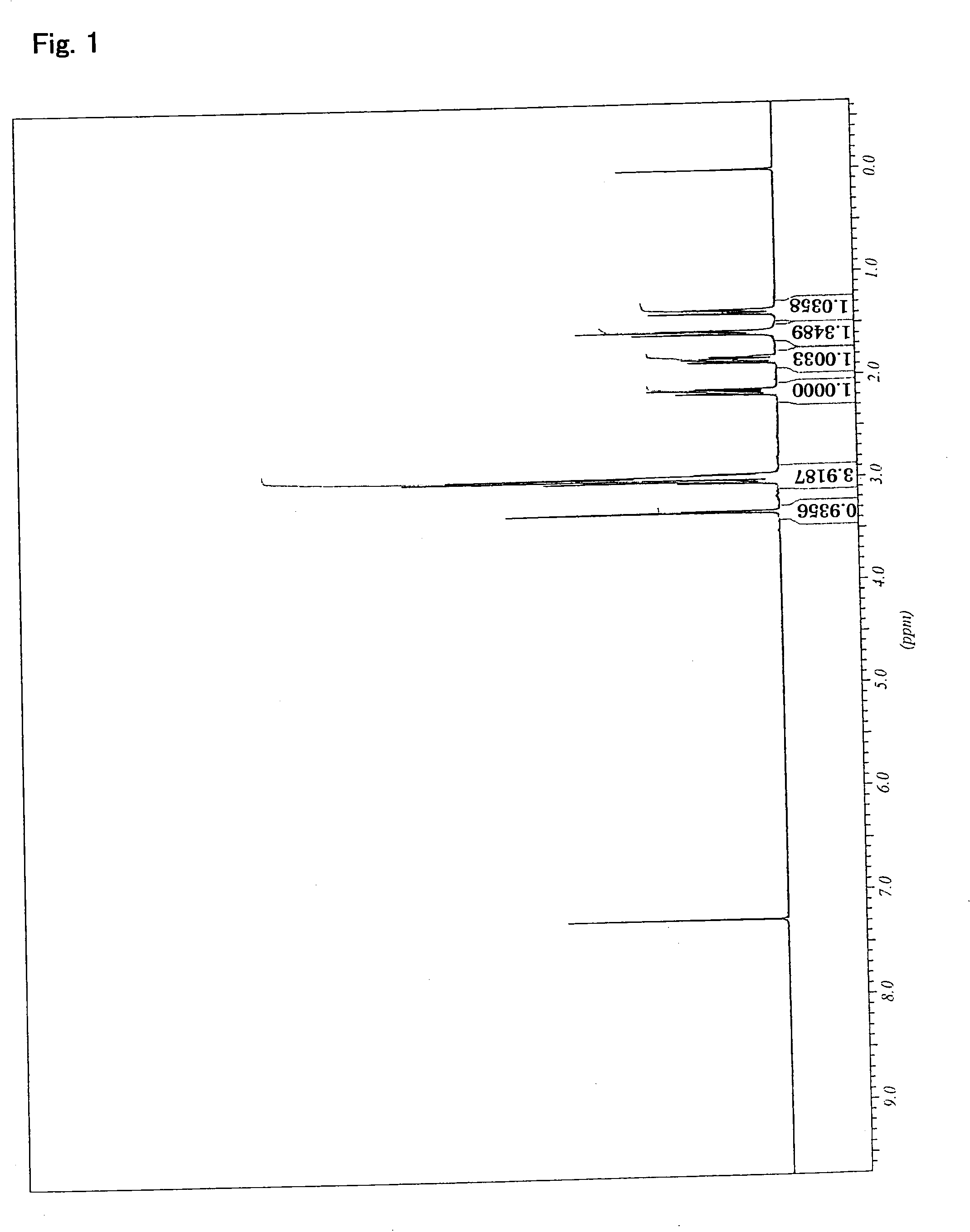Tetracarboxylic acid compound, polyimide thereof, and production method thereof
a technology of tetracarboxylic acid and polyimide, which is applied in the direction of non-linear optics, synthetic resin layered products, domestic applications, etc., can solve the problems of difficult application of achromatic transparency to the purpose of use at high temperatures, low heat resistance of each, and limited use for purposes in which achromatic transparency is particularly required. , to achieve the effect of excellent properties, low dielectric properties and high transparency
- Summary
- Abstract
- Description
- Claims
- Application Information
AI Technical Summary
Benefits of technology
Problems solved by technology
Method used
Image
Examples
example 1
[0403]An aqueous solution in which 30.0 g (111 mmol) of norbornane-2-exo,3-exo,5-exo-tricarboxylic acid trimethyl ester, 30.0 g of sulfolane, and 10.9 g of sulfuric acid were dissolved in 50.0 g of water was put in a reaction container provided with a nitrogen introduction pipe and a condenser, and heating was conducted at 104° C. for 5 hours in nitrogen atmosphere. In the meantime, 17 g per hour of water was added while distilled methanol and water were removed to the outside of the system. Cooling was conducted after the reaction, 150 g of water was added, and extraction was conducted with toluene (200 ml×4 times). After 70 g of sodium chloride was added to the water layer, extraction was conducted with a mixture solvent (200 mL×2 times, 100 mL×once) of tetrahydrofuran / ethyl acetate (1 / 1) (volume ratio). The resulting tetrahydrofuran / ethyl acetate layer was washed with a saturated saline solution (100 mL×once). Subsequently, the tetrahydrofuran / ethyl acetate layer was concentrated...
example 2
[0404]After 20.1 g (87.7 mmol) of norbornane-2-exo,3-exo,5-exo-tricarboxylic acid obtained by a method in Example 1, 32 mg (0.44 mmol; 0.005 molar equivalent relative to tricarboxylic acid) of dimethylformamide, and 100 mL of toluene serving as a solvent were put in a reaction container provided with a nitrogen introduction pipe and a condenser, heating was conducted in such a way that the inner temperature became 70° C. Then, 31.3 g (263 mmol; 3.0 molar equivalent relative to tricarboxylic acid) of thionyl chloride was added thereto, and reflux was conducted for 2 hours in a nitrogen atmosphere. Subsequently, excess thionyl chloride and 81 g of toluene were removed by distillation under reduced pressure. The residual solution was blended with 200 mL of heptane so as to precipitate a crystal. The resulting crystal was filtrated and, thereby, 16.0 g (crude yield 80%) of white crystal of crude 5-exo-chloroformyl-norbornane-2-exo,3-exo-dicarboxylic anhydride was obtained. This crystal ...
example 3
[0409]In a nitrogen atmosphere, 2.89 g (26.3 mmol) of hydroquinone, 16.6 g of pyridine, and 70 mL of tetrahydrofuran were put in a reaction container so as to dissolve. The resulting mixture was cooled to 2° C. in an ice bath. Thereafter, a solution in which 12.0 g (52.5 mmol; 2.0 molar equivalent relative to hydroquinone) of 5-exo-chloroformyl-norbornane-2-exo,3-exo-dicarboxylic anhydride was dissolved by adding 50 mL of tetrahydrofuran was dropped over 15 minutes with a dropping funnel, and agitation was further conducted for 5 hours so as to obtain a white precipitate. The resulting white precipitate was separated by filtration and was suspended in 150 mL of water, followed by filtration. Furthermore, hydrochloric acid salts were removed completely by washing with water sufficiently. The resulting product was vacuum-dried at 150° C. for 20 hours, so that 11.1 g (recovery factor 85%) of white powder was obtained.
[0410]The resulting product was identified as 1,4-bis(4′-oxa-3′,5′-di...
PUM
| Property | Measurement | Unit |
|---|---|---|
| Temperature | aaaaa | aaaaa |
| Temperature | aaaaa | aaaaa |
| Length | aaaaa | aaaaa |
Abstract
Description
Claims
Application Information
 Login to View More
Login to View More - R&D
- Intellectual Property
- Life Sciences
- Materials
- Tech Scout
- Unparalleled Data Quality
- Higher Quality Content
- 60% Fewer Hallucinations
Browse by: Latest US Patents, China's latest patents, Technical Efficacy Thesaurus, Application Domain, Technology Topic, Popular Technical Reports.
© 2025 PatSnap. All rights reserved.Legal|Privacy policy|Modern Slavery Act Transparency Statement|Sitemap|About US| Contact US: help@patsnap.com



